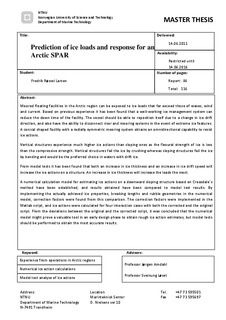| dc.contributor.author | Larsen, Fredrik Røssel | nb_NO |
| dc.date.accessioned | 2014-12-19T12:06:41Z | |
| dc.date.available | 2014-12-19T12:06:41Z | |
| dc.date.created | 2012-02-08 | nb_NO |
| dc.date.issued | 2011 | nb_NO |
| dc.identifier | 494255 | nb_NO |
| dc.identifier.uri | http://hdl.handle.net/11250/237976 | |
| dc.description.abstract | Moored floating facilities in the Arctic region can be exposed to ice loads that far exceed those of waves, wind and current. Based on previous experience it has been found that a well-working ice management system can reduce the down time of the facility. The vessel should be able to reposition itself due to a change in ice drift direction, and also have the ability to disconnect riser and mooring systems in the event of extreme ice features. A conical shaped facility with a radially symmetric mooring system obtains an omnidirectional capability to resist ice actions.
Vertical structures experience much higher ice actions than sloping ones as the flexural strength of ice is less than the compressive strength. Vertical structures fail the ice by crushing whereas sloping structures fail the ice by bending and would be the preferred choice in waters with drift ice.
From model tests it has been found that both an increase in ice thickness and an increase in ice drift speed will increase the ice actions on a structure. An increase in ice thickness will increase the loads the most.
A numerical calculation model for estimating ice actions on a downward sloping structure based on Croasdale`s method have been established, and results obtained have been compared to model test results. By implementing the actually achieved ice properties, breaking lengths and rubble geometries in the numerical model, correction factors were found from this comparison. The correction factors were implemented in the Matlab script, and ice actions were calculated for four interaction cases with both the corrected and the original script. From the deviations between the original and the corrected script, it was concluded that the numerical model might prove a valuable tool in an early design phase to obtain rough ice action estimates, but model tests should be performed to obtain the most accurate results. | nb_NO |
| dc.language | eng | nb_NO |
| dc.publisher | Norges teknisk-naturvitenskapelige universitet, Fakultet for ingeniørvitenskap og teknologi, Institutt for marin teknikk | nb_NO |
| dc.title | Prediction of ice loads and response for an Arctic SPAR | nb_NO |
| dc.title.alternative | Beregning av islaster og respons for en arktisk SPAR | nb_NO |
| dc.type | Master thesis | nb_NO |
| dc.contributor.department | Norges teknisk-naturvitenskapelige universitet, Fakultet for ingeniørvitenskap og teknologi, Institutt for marin teknikk | nb_NO |
